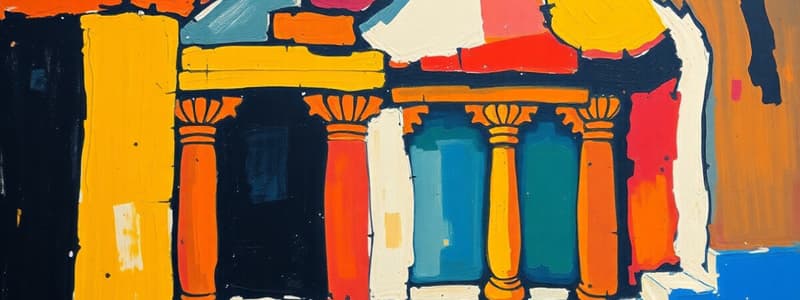Podcast
Questions and Answers
Which of these periods is considered the "Transitional Period"?
Which of these periods is considered the "Transitional Period"?
- Mogul Period
- Islamic Ascendancy/ Transitional Period (correct)
- Classical Period
- Ancient Period
The Ajanta Caves are considered masterpieces of what type of art?
The Ajanta Caves are considered masterpieces of what type of art?
- Islamic Art
- Hindu Art
- Jain Art
- Buddhist Art (correct)
What is the significance of the four-armed figure representing Shiva the Cosmic-dancer?
What is the significance of the four-armed figure representing Shiva the Cosmic-dancer?
- It symbolizes Shiva's power over the elements of nature.
- It represents Shiva's role as the creator, preserver, and destroyer.
- It represents Shiva's ability to control the cycle of birth and death.
- All of the above. (correct)
Which of the following is NOT a characteristic of Shiva in his Cosmic-dancer form?
Which of the following is NOT a characteristic of Shiva in his Cosmic-dancer form?
Which of these monuments is NOT related to Buddhism?
Which of these monuments is NOT related to Buddhism?
What is the architectural contribution of the Mogul Period to Indian culture?
What is the architectural contribution of the Mogul Period to Indian culture?
Which of the following statements accurately describes the Ajanta Caves?
Which of the following statements accurately describes the Ajanta Caves?
What does the text suggest was the main influence on the transition from Vedism to Hinduism?
What does the text suggest was the main influence on the transition from Vedism to Hinduism?
Flashcards
Ancient Period
Ancient Period
The period in Indian arts from 3900 BCE to 1200 CE, marked by significant developments such as the Ajanta Caves.
Ajanta Caves
Ajanta Caves
A series of rock-cut caves in Maharashtra, India, known for their remarkable Buddhist art from 2nd century BCE to 600 CE.
Shiva
Shiva
A principal Hindu deity representing destruction and transformation, often depicted as a four-armed dancer.
Islamic Ascendancy
Islamic Ascendancy
Signup and view all the flashcards
Mahabharata
Mahabharata
Signup and view all the flashcards
Mogul Period
Mogul Period
Signup and view all the flashcards
Taj Mahal
Taj Mahal
Signup and view all the flashcards
Borobudur
Borobudur
Signup and view all the flashcards
Study Notes
Periods of Indian Arts
- Indian art spans various periods, each with unique characteristics.
- The periods are: Ancient Period, Classical Period, Islamic Ascendancy/Transitional Period, and Mogul Period.
- Ancient Period art is a broad category encompassing early forms.
- Classical Period, lasting from the 5th to 6th centuries, saw Shiva evolving into the cosmic-dancer depicted as a four-armed figure.
- The Islamic Ascendancy/Transitional Period (1192-1757) witnessed the evolution from Vedism to Hinduism or Brahmanism.
- The Mahabharata and Ramayana epics emerged during this time.
- The Mogul Period (16th century) saw Mogul contributions to Indian culture through painting and architecture.
- The Taj Mahal, built in 1632 by Shah Jahan, stands as a magnificent example of Mogul architecture.
Ajanta Caves
- Ajanta Caves are an impressive example of ancient art.
Borobudur
- Borobudur, a Buddhist monument in Java, was built in the 8th century after the decline of Buddhism in India.
Diwali
- Diwali, a Hindu festival, is celebrated yearly around October or November.
- Diwali is a 3- or 5-day holiday depending on regional traditions.
- Homes are cleaned to welcome the New Year.
- Clay lamps (diyas) are lit to light the way for the goddess Lakshmi, the goddess of wealth.
- Diwali is also known as the Festival of Lights.
Studying That Suits You
Use AI to generate personalized quizzes and flashcards to suit your learning preferences.




